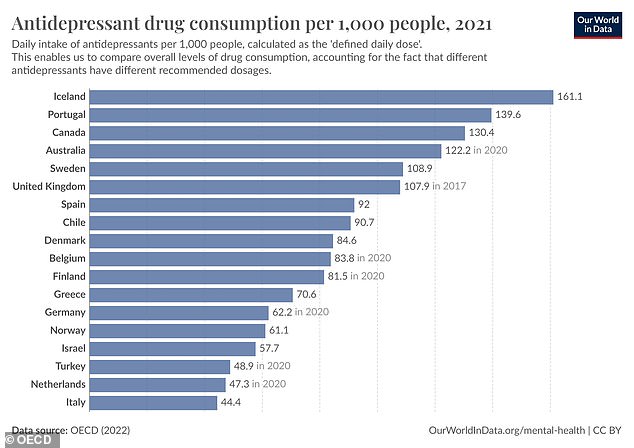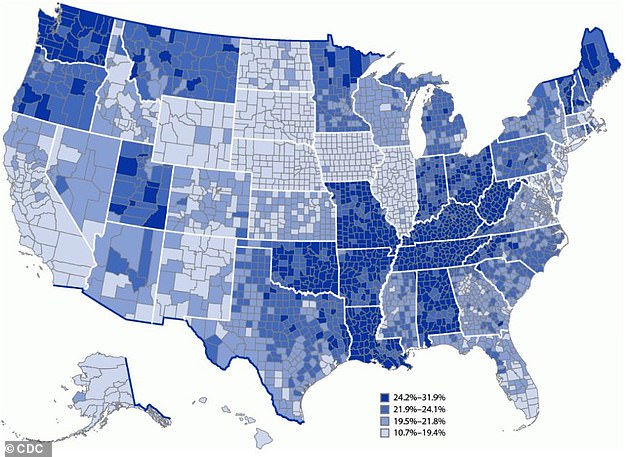Countries where antidepressants are most commonly prescribed around the world REVEALED
America is often labeled as the most depressed or drugged-out country, but that may be incorrect.
Figures on global per capita use of antidepressants indicate that Iceland has the largest share of its citizens on the drugs.
Figures compiled by Our world in data analyzed the number of prescriptions written in 22 countries, broken down as a percentage per 1,000 people.
Data from the Organization for Economic Co-operation and Development (OECD) shows that Iceland tops the list, with 161.1 per 1,000 inhabitants, the equivalent of one in six inhabitants.
Iceland had the highest number of prescriptions for antidepressants, with 161 per 1,000 inhabitants. Meanwhile, South Korea came in last with 27 per 1,000

The two main classes of antidepressants are tricyclic antidepressants and selective serotonin reuptake inhibitors (SSRIs). SSRIs are more common
The country – which notoriously has long, dark winters – has fewer than 400,000 inhabitants.
Portugal and Canada followed closely, with 139 and 130 scripts per 1,000 respectively.
The US has a rate of 110 per 1,000 inhabitants, putting the country in fifth place.
Britain followed closely in seventh place, with 108 prescriptions per 1,000 Britons.
Meanwhile, South Korea ranks bottom, with 27 prescriptions per 1,000 residents, where depression and therapy are largely considered taboo.
The findings come as one in three Americans suffer from clinical depression at some point in their lives, and one in five currently have the disorder.
The two main classes of antidepressants are tricyclic antidepressants and selective serotonin reuptake inhibitors (SSRIs).
Tricyclic antidepressants are an older class of drugs that are less commonly prescribed due to more intense side effects, including insomnia, bedwetting, and chronic pain conditions such as fibromyalgia.
These work by increasing the mood-boosting hormones norepinephrine and serotonin.
Some examples of tricyclics approved by the Food and Drug Administration (FDA) include amitriptyline (Elavil), nortriptyline (Pamelor), and protriptyline (Vivactil).
SSRIs are more common and include medications such as citalopram (Celexa), escitalopram (Lexapro), fluoxetine (Prozac), paroxetine (Paxil), and sertraline (Zoloft).
These work by preventing serotonin from being reabsorbed by neurons.

The US was not included in the OECD rankings, although the country was ranked fifth by CDC estimates

The percentage of adults who say they have been diagnosed with depression during their lifetime
Iceland has the highest rate of antidepressant use, the OECD found, with 161.1 scripts per 1,000 people.
However, experts believe that this is not due to the dark, cold winters and early sunsets, but to the cheap medicines.
As of 2023, the World Happiness Report ranked Iceland as the third happiest country in the world, behind Finland and Denmark.
The report found that the country had the highest sense of social support and the second highest generosity score.
Furthermore, Al Jazeera estimates that the prices of medicines in Iceland are seven times cheaper than those of therapies, which could explain why so many residents use them.
Although the US is not included in the OECD rankings, the CDC estimates that 110 out of every 1,000 Americans use antidepressants, which amounts to about 11 percent.
The agency also noted that these are more common in women, 18 percent of whom have used them in the past 30 days, compared to eight percent of men.
In a report released last year, the CDC found that up to a third of Americans suffer from depression, with West Virginia counties scoring the highest.
Researchers believe that depression is higher in West Virginia, Kentucky, Tennessee and Washington counties due to the prevalence of other chronic diseases, such as diabetesand other social factors, including poverty.
West Virginia and Kentucky have the highest obesity rates in the country. West Virginia is also one of the poorest states in the country.
“There was significant geographic variation in the prevalence of depression, with the highest state and county estimates of depression observed in the Appalachian and southern Mississippi Valley regions,” researchers wrote in the report.
Additionally, a CDC report published last month found that 37.9 million Americans lived alone in 2022, an increase of 4.8 million – 15 percent – over 2012 numbers.
The research also showed that the share of the adult population living in single-person households has doubled since the 1960s: from 13 percent to more than 29 percent.
The report warned that there is an ‘increased risk of adverse mental health’ for single people – adding that those living alone were 64 per cent more likely to have symptoms of depression than those living together.
Researchers also said these numbers may be driving the sense of despair and high rates of mental health problems in the US.
Britain came in two places below the US, with 108 prescriptions per 1,000 inhabitants.
NHS data shows that eight million patients across England are prescribed these drugs for problems such as depression and anxiety.
However, a 2023 report from the agency also notes that one in four of them – about two million – have taken the drugs for at least five years.
And England also handed out around 1 million antidepressant prescriptions for teenagers in 2022, NHS data shows.
South Korea was at the bottom of the list with 27 prescriptions per 1,000 inhabitants.
Researchers in a European Journal of Public Health study attributed this low rate to the fact that the drugs were not available in all parts of the country.
Another study found that South Koreans are more likely to see depression as a sign of weakness.
